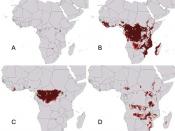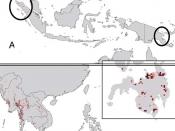The Hot Zone delves into the history behind the spread of the Ebola Zaire virus. In 1976 Ebola was discovered in its hiding place in the Kitum Cave in the jungles of Africa. In its two outbreaks in Zaire and Sudan, the Ebola virus wiped out six hundred people. Ebola does in ten days what it takes HIV ten years to accomplish. The virus had never been seen outside of Africa, and now there was a possibility that this virus was in Washington, D.C. In 1989, research monkeys, housed at the Reston Primate Quarantine Unit in Reston, Virginia began dying from an unknown disease at an alarming rate. These monkeys were imported from the Philippines, and were sold for laboratory research. One hundred monkeys were shipped and twenty-mine of the monkeys died within one month. Veterinarians from the United States Army Medical Research Institute of Infectious Disease (USAMRIID) were brought in to assist in this investigation.
Upon reading The Hot Zone, you realize the conflict of the various government agencies that want to be the lead agency. The army feels that it should retain jurisdiction because of the potential national security issue. The Center for Disease Control located in Atlanta is vying for control because of the potential impact of an Ebola outbreak. Each agency wants to guard the information and refuses to cooperate and wants to maintain an independent investigation.
While reading this book, I learned a valuable lesson about teamwork. Local law enforcement agencies conduct thousands of criminal investigations each year and most of them are conducted with minimal assistance from other agencies. If a local agency had to investigate an Ebola outbreak, several issues would arise. First of all, who would become the lead investigator agency and what resources would be available? Networking with federal and state agencies is imperative in handling potential disease exposures.
The other concern for law enforcement is the uses of the Ebola virus as a Weapon of Mass Destruction. With new technology being discovered on a daily basis, introduction of the Ebola virus remains a threat to law enforcement. I would highly recommend this book to anyone that is interested in communicable disease, and how the impact can change society.





